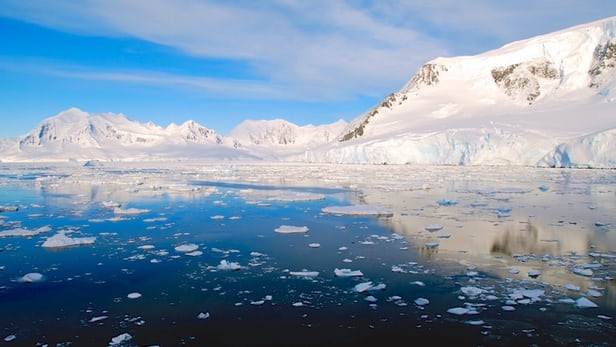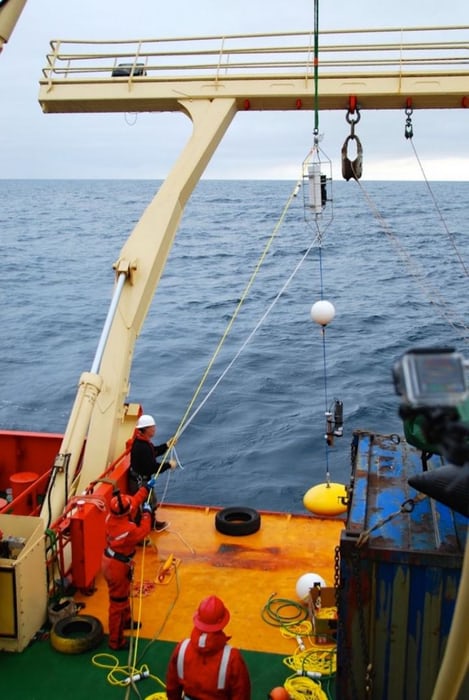Hi-tech mooring records ocean acidity beneath Antarctic ice

It's the first time that both a CO2 and pH sensor have been deployed in the continental shelf waters of the Southern Ocean(Credit: E. Shadwick/VIMS)
Researchers from the Virginia Institute of Marine Science have deployed an innovative, sensor-studded mooring – as tall as the Empire State Building – beneath waters in Antarctica usually inaccessible through the winter.
Oceans play a major role in soaking up the carbon dioxide added to the atmosphere by fossil fuels and other human activities. In fact, the oceans have absorbed about a third of this CO2, with the Southern Ocean in Antarctica taking a starring role by soaking up almost half the total emissions taken in by seawater.
This is great news for the atmosphere, but the bad news is that CO2 increases the acidity of seawater, and marine life is sensitive to this acidity.
Scientists are particularly concerned about microscopic organisms at the bottom of the food web, such as krill, which impact animals further up the chain, including penguins, fish, seals and whales. Shipboard measurements from recent Antarctic summers suggest that rising CO2 concentrations could begin harming animals that form shells or skeletons from calcium carbonate minerals by around 2070.
This projection doesn't take the winter months into account at all, and scientists are concerned that the winter months could pose an even greater threat to local marine life. In winter, algal blooms release CO2 into the water through respiration or decay rather than removing CO2 from the water through photosynthesis and the other new growth cycles that occur in summer.
"Using sparse observations of wintertime conditions, our models predict the Southern Ocean will become under saturated with respect to carbonate by the year 2030," said Dr. Elizabeth Shadwick.
It's clear that gathering a broader and more
accurate data set is critical to clarifying these predictions.
The mooring, which is anchored to the seafloor in around 1,600
ft (487.68 m) of water, carries an array of hi-tech sensors that
record the temperature and concentrations of dissolved carbon
dioxide, salinity and pH levels of the south polar waters. The
data will be stored in waterproof memory cards until the line is
retrieved.
If the line performs as promised, it will extend the amount of information usually gathered in the region from the brief, ice-free period of summer (when research and supply ships can enter the area) to the entire year.
Dr. Shadwick and marine technician Olivia De Meo deployed the mooring last month from the deck of the research vessel Laurence M. Gould. "This is the first time that both a CO2 and pH sensor have been deployed in the continental shelf waters of the Southern Ocean," Dr. Shadwick told New Atlas. "The CO2 system in seawater has four parameters that can be measured directly, [but] for now, only two of these (CO2 and pH) can be measured autonomously at depth."
The researchers plan to recover the mooring in early
May, at the same time deploying a second, identical mooring.
This will be recovered the following December.
Retrieval involves using stored GPS coordinates to re-locate the mooring, which is tethered well below the water surface. The team will then free it from its seabed tether by pinging a release mechanism with an acoustic signal. The mooring should then float to the surface, where crewmembers will hook it with a grapple and hoist it aboard.
Dr Shadwick told New Atlas the project is not without risk. "The surface float is at about 20 meters below the sea surface, which should keep the mooring out of the way of sea-ice through the winter. But if a large (or even not so large) iceberg were to float by, it would likely take out the mooring entirely, or drag the instrument packages down into much deeper water where they would be damaged. We have chosen a location where this is unlikely, but it is always a risk with working in the Antarctic."
The mooring was designed in collaboration with Columbia University and with input from the Australian-based Antarctic Climate & Ecosystems CRC. It now lies within the study area of the Palmer Antarctic Long-Term Ecological Research program.
Data from the mooring should lead to a better understanding of the impact of climate change on the Earth's oceans, and help with impact predications.

